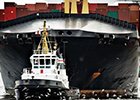A change of strategy is required

Drewry Maritime’s latest Container Forecaster report highlights that carriers need to rely less on the chronic use of general rate increases (GRIs) and pay more attention to minimising surplus capacity at the trade route level to stabilise the shipping market.
Future industry health is now being governed by carrier behaviour and psychology rather than the prevailing market fundamentals which we believe will remain weak for the next two years at least.
Senior industry figures stated that much more would be done this year to adjust capacity in line with ailing demand through scrapping, slow steaming and idling, but they have not delivered. With global container traffic only forecast to grow by 3.7% this year, the carriers need to adjust their deployment at the trade route level and while scrapping levels are high, slow steaming has not increased by any significant level. Global fleet idling in early June was a mere 3% and continues to decline when all the signals heavily suggest that carriers should lay up more tonnage.
Carriers’ reluctance to engage in more radical changes on the supply front did not fully explain the reason for a 56% decline and 19% drop respectively in spot freight rates on the Asia-North Europe and Asia to USWC trades between early April and end-June. Regretfully, carriers were engaging in yet another rate war with nobody willing to relinquish market share. Spot freight rates on the Asia-North Europe trade fell to the same disastrous level of less than ,000 per feu – as they were back in late 2011.
The practice of void sailings has not been nearly enough to manage trade route supply and at best has merely improved load factors in any one individual week in order to stop further rate erosion.
The end of June represented another trigger point for the industry since the 1 July east-west trade GRIs were crucial to lift spot rates to above break-even levels and avoid the costly re-negotiation of many BCO contracts signed in early 2013 at much higher rates.
Early indications are that Asia to North Europe spot rates are now back up to ,300-,500 per feu, indicative of a high level of initial success, but how long will this momentum last for ocean carriers since we are not expecting a big peak season for the second year in a row?
Hanjin and MOL have already announced another westbound GRI of 0 per teu to take effect from 1 August. Other lines no doubt will follow this lead.
Neil Dekker, Drewry’s Head of Container Research, stated: “We are stuck in a vicious rut of GRI, followed by rapid rate erosion, followed by another GRI. Carriers cannot achieve market stability unless they are prepared to adjust capacity in line with weak demand and finally accept that we will no longer have 8-10% annual demand growth on the east-west trades. The delivery of ever more 10,000 teu levels and the recent surge in the orderbook for more ULCCs is not helping sentiment. A change of strategy by the carriers is urgently required.
Drewry believes a step in the right direction is the announcement by Maersk, MSC and CMA CGM that they will collectively adjust their capacity in the three main east-west trades in a new operational alliance (P3) to commence in early 2014 (and subject to regulatory approval). It should be seen as a catalyst to try and aid some of the current problems, although these three lines cannot repair the industry damage all by themselves.

